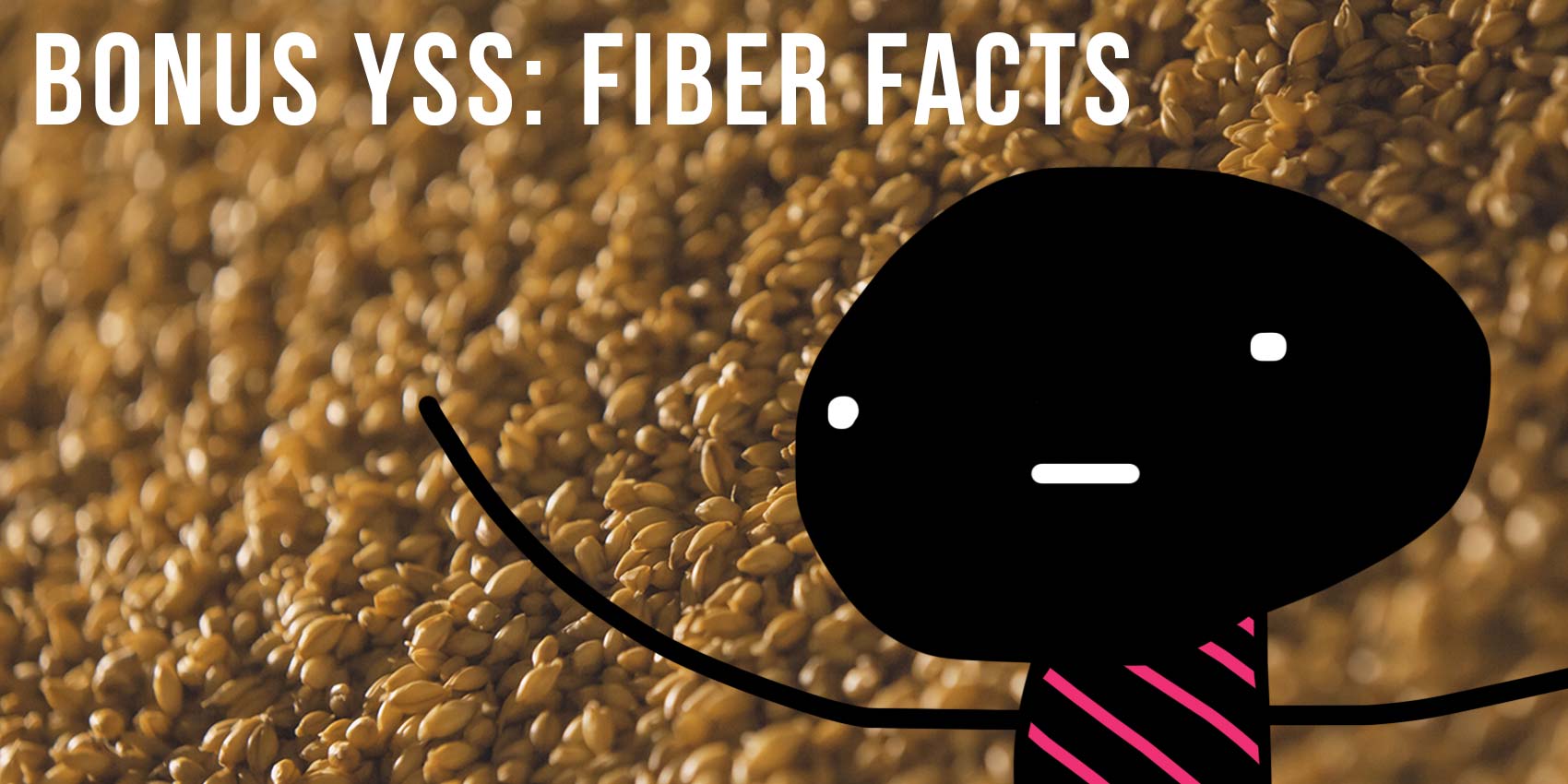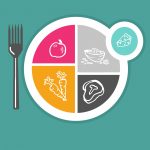14 Sep Bonus YSS: Fiber facts

(all information provided by the Institute for Functional Medicine)
Fiber is a critical part of your diet. You need fiber for a variety of reasons, but two of the most important ones are that fiber helps fight disease and it also helps you to feel full for longer (which helps you to not overeat).
First, you’ll need to know this highly technical stuff about fiber: Plant cells have varying compositions of both soluble and insoluble fibers. HUH? Here’s the breakdown:
Insoluble fiber is also called crude fiber. It is the fiber responsible for lowering your absorption of cholesterol, maintaining healthy sugar levels and keeping you feeling full for longer. Foods that contain this important type of fiber are:
- Oats
- Legumes (beans)
- The skin of an apple
- Nuts and seeds
Soluble fiber (the other type of fiber) is also called dietary fiber. It is plant material that is normally left undigested after passing through the body’s digestive system. It helps to pass food through your system, which is important! Soluble fiber acts as a cancer preventative. Foods that contain more of this fiber are:
- Wheat bran
- Apples
- cabbage
- flaxseeds
- Nuts and seeds (yes! they contain equal amounts of both fibers!)
Soluble fiber is the kind that tends to form gels, allowing the body’s waste to form into soft and bulky stools which function to more efficiently sweep out toxins and potential toxins. By decreasing the length of time food stays in the intestinal tract, fiber decreases the incidence of fermentation of food – okay, no need to get all scientific, just know that that’s a really good thing! Now you know why we call fiber your body’s “broom”—it sweeps you out and keeps your digestive tract clean.

DID YOU KNOW? Dietary fiber helps to bind onto some toxic substances in the colon, thereby reducing their negative effects.
(Source, Mary Gocke, RD, New York
In general, both types of fiber also increase the time it takes to empty the stomach, allowing for gastric juices to more fully break the food down. That’s good too! Plus, fiber lowers serum cholesterol significantly, maintaining healthy arteries.
Below is a list of typical fiber contents in foods to help you increase your fiber intake! The average American eats about 10 grams a day but the National Cancer Institute recommends 25-30 grams per day for teens and 40-50 grams per day for adults!!! Try reading your food packaging for a day and keep track of how many grams you eat!! Just don’t forget to drink plenty of water when you increase your fiber intake so you don’t get “clogged.” Too much fiber can be binding so water is essential to sweep everything along.

DID YOU KNOW? The worldwide average fiber intake is much higher than in the U.S. – about 50-75 grams per person compared to Americans.
Notice how much more fiber is found in whole grains than in the refined and processed ones. And check out the fruits and veggies—yet another reason to make a smoothie for breakfast or a big salad for lunch.
BEANS AND TOFU: Product Fiber (g)/serving
Beans or Lentils (1/2 c., cooked) 5-8
Boca Burger or Garden Burger (1) 4
BREADS: Product Fiber (g) /serving (1 slice)
Tortilla, Low carbohydrate 8-9
Pita, Whole Wheat 5
Tortilla, Whole Wheat 2
Pumpernickel or rye bread 2
Ezekiel Sprouted Grain 3
Pita1 or Tortilla, White Flour 1
GRAINS AND PASTA: Product Fiber (g) /serving
Barley (1 c.) or Bulgur (3/4 c.) 6
Whole wheat macaroni or spaghetti (1 c.) 4
Brown rice (3/4 c.) 3
Couscous, Macaroni, or Spaghetti (1 c.) 2
White Rice (2/3 c.) 1
Rice Noodles 0
CEREALS (serving size and calories vary with each cereal): Product Fiber (g) /serving
General Mills Fiber One (1/2 c. 60 cal) 14
Kashi Good Friends (1 cup 170 cal) 12
Kellogg’s All-Bran with Extra Fiber (1/2 c. 80 cal) 10
Post Shredded Wheat ‘n Bran (1 ¼ cups 200 cal) 8
Cascadian Farm Hearty Morning (3/4 c. 200 cal) 8
Kellogg’s Raisin Bran (1 c. 190 cal) 7
Kashi Seven in the Morning (½ c 210 cal) 7
Post Shredded Wheat (1 c. 170 cal) 6
Post Grape Nuts (1/2 c. 200 cal) 6
Quaker Oat Bran Cereal (1 c., ckd. 150 cal) 6
Quaker Crunchy Corn Bran (3/4 cup 90 cal) 5
Post Bran Flakes (¾ cup 100 cal) 5
Health Valley Oat Bran Flakes (3/4 cup 110 cal) 4
Quaker Quick Oats or instant oatmeal (1 c., ckd 150 cal) 4
Cheerios, Cascadian Farm Breakfast O’s, or Wheaties (1 c. 110 cal) 3
Kellogg’s Corn Flakes, Product 19, Rick Krispies, Special K (1 c. 100 cal) 1
CRACKERS AND SNACK FOODS: Product Fiber (g)/serving
Wasa Fiber Plus Crispbread (3) 9
Wasa Hearty Rye Crispbread (3) 7
Wasa Fiber Rye (3) 6
No-Oil Tortilla Chips (15-20) 2-4
Whole Wheat Matzos (1) 4
Popcorn (4 c.) 3-4
Triscuits (13) 3
Peanuts ¼ cup 3
Stoned Wheat Thins (4) 1
Quaker Rice Cakes (1) 0
FRUITS AND JUICES: Product Fiber (g) /serving
Raspberries 8
Blackberries (1 c.) 8
Strawberries (2 c.) 7
Blueberries, raw (1 c.) 7
Cranberries (1 c.) 4
Figs, dried (2) 5
Apple (1) or Pear (1) with skin 4
Apple, without skin (1) 3
Prunes, dried (5) 3
Fresh figs (2) 3
Apricots (4) 3
Banana (1) or Orange (1) 3
Cantaloupe (2 c.) 2
Cherries (15 ) 2
Apricots, dried (1/4 c.) 2
Nectarine (1), Plums (2), or Peach (1) 2
Watermelon (2 c.) 2
Grapes (20), or Grapefruit (1/2) 1
Orange juice (1 c.) 0
VEGETABLES: Product Fiber (g) /serving
Green peas (1/2 c. frozen) 5
Green peas (1/2 c. canned) 4
Broccoli (1 c. cooked) 5
Broccoli (1 c. raw) 3
Sweet potato, medium, baked with skin, (1) 4
Potato, medium, baked with skin (1) 3
Corn (1/2 c fresh, canned or frozen) 3
Spinach1 (1/2 c. cooked) 3
Cabbage (1 c. shredded, cooked) 3
Brussels sprouts (5) 3
Carrots (1/2 c. cooked ) 3
Carrots, raw (1/2 c.) 2
Cauliflower or Green beans (1/2 c. cooked) 2
Lettuce, romaine (1 1/2 c.) 2
Lettuce, iceberg (1 1/2 c.) 1




Answer the post question here
What's being said